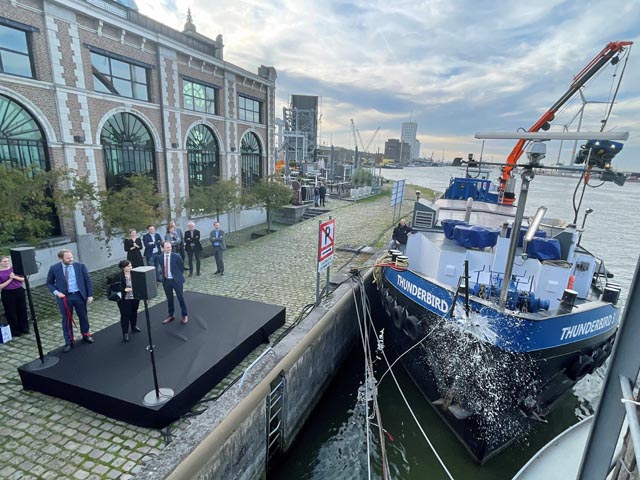As hull biofouling and its role in invasive species transfer and carbon emissions due to increased fuel use continue to attract the attention of the IMO and national regulators, Netherlands-based Fleet Cleaner has added to its armoury with the introduction of a third specialist hull cleaning vessel.
In addition, the company has unveiled a new remotely controlled operation service for its growing fleet of vessels and ROV cleaning craft. Thunderbird 3, a converted former inland general cargo craft, has been christened in a ceremony in Antwerp.
Cornelis de Vet, co-founder and COO Fleet Cleaner, said: “MSC was one of the first companies giving us the opportunity to prove our technology. It’s an honour to have them christen our new vessel and also have them as a valued customer, along with our other customers and stakeholders who are working to improve the sustainability of the industry and oceans.”
Marianna Mastellone, new building project manager and energy manager at ship manager MSC Sorrento, said: “We at MSC are always looking for innovations that can help improve efficiency through the water and, therefore, help us to minimise fuel consumption. Fleet Cleaner with its new vessel can help us as we continue to strive towards our goal of net zero decarbonisation.”
The whole vessel including its engine room and equipment on deck is all ATEX certified so there is no risk of explosion when carrying out operations thus making it suitable for cleaning all ship types during cargo operations at terminals, including tankers. The vessel is able to clean up to 150 ships a year and Fleet Cleaner calculates emissions are reduced significantly, equivalent to that from around 200.000 cars a year.
The hydraulically powered ROV is also ATEX certified. It is attached to the vessel using magnets and has an umbilical connection to Thunderbird 3 through which filtered seawater is pumped to the ROV for use as a pressurised cleaning medium. The pressure can be adjusted according to the degree of fouling and the types of coatings used. The cleaning heads are flexible and can move in all directions so the ROV can be used with confidence on different ship types. The ROV has various aids to help the operator with cleaning and inspection, including lights, cameras front and back, and various sensors that helps the operator navigate over the hull surface. It can cover up to 2,000m2/hr and is designed for 50m underwater operation. All removed fouling is collected and transported via the umbilical back to Thunderbird 3 where it is filtered and stored onboard or transported by barge if the job is a large one. The cleaned filtered water can be released back into the port.
Previously, Fleet Cleaner’s ROVs needed to be controlled and operated from the vessels themselves but the opening of the remote control centre in Delft means that operators can continue to work around the clock and the number of crew on the vessels can be reduced. To aid the remote operator, specialised software is used to load the hull drawings of the ship so that the cleaning process is better planned and controlled.
Fleet Cleaner’s operations and methods have been approved by authorities in the Netherlands and Belgium and the company is looking to expand by adding two more vessels. By the end of 2022, it expects to be performing daily inspections in seven countries.



